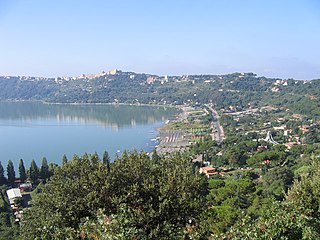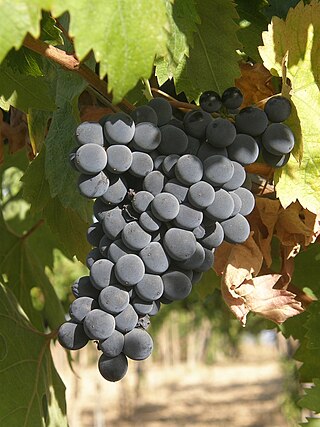
Castel Gandolfo, colloquially known as Castello in the Castelli Romani dialects, is a town located 25 km (16 mi) southeast of Rome, in the Italian region of Lazio. Situated on a hilltop in the Alban Hills with panoramic views of Lake Albano, Castel Gandolfo is home to approximately 8,900 residents and is renowned as one of Italy's most scenic towns. It is one of I Borghi più belli d'Italia.

Albano Laziale is a comune (municipality) in the Metropolitan City of Rome Capital, on the Alban Hills, in the Italian region of Lazio. Rome is 25 kilometres (16 mi) distant. It is bounded by other communes of Castel Gandolfo, Rocca di Papa, Ariccia and Ardea. Located in the Castelli Romani area of Lazio. It is sometimes known simply as Albano.

Velletri is an Italian comune in the Metropolitan City of Rome, approximately 40 km to the southeast of the city centre, located in the Alban Hills, in the region of Lazio, central Italy. Neighbouring communes are Rocca di Papa, Lariano, Cisterna di Latina, Artena, Aprilia, Nemi, Genzano di Roma, and Lanuvio. Its motto is: Est mihi libertas papalis et imperialis.

Lake Albano is a small volcanic crater lake in the Alban Hills of Lazio, at the foot of Monte Cavo, 20 km (12 mi) southeast of Rome. Castel Gandolfo, overlooking the lake, is the site of the Papal Palace of Castel Gandolfo.

Castel del Monte is a 13th-century citadel and castle situated on a hill in Andria in the Apulia region of southeast Italy. It was built during the 1240s by King Frederick II, who had inherited the lands from his mother Constance of Sicily. In the 18th century, the castle's interior marbles and remaining furnishings were removed. It has neither a moat nor a drawbridge and some considered it never to have been intended as a defensive fortress. However, archaeological work has suggested that it originally had a curtain wall.

Ariccia is a town and comune in the Metropolitan City of Rome, central Italy, 25 kilometres (16 mi) southeast of Rome. It is in the Alban Hills of the Lazio (Latium) region and could be considered an extension of Rome's southeastern suburbs. One of the Castelli Romani towns, Ariccia is located in the regional park known as the "Parco Regionale dei Castelli Romani".

Marcantonio II Colonna, Duke of Tagliacozzo and Duke and Prince of Paliano, was a Roman aristocrat who served as Viceroy of Sicily in the service of the Spanish Crown, general of the Spanish forces, and Captain General of the Church. He is best remembered for his part as the admiral of the Papal fleet in the Battle of Lepanto. He was "one of the most illustrious land and sea captains of the 16th century".

Marino is an Italian city and comune in Lazio, on the Alban Hills, Italy, 21 kilometres southeast of Rome, with a population of 37,684 and a territory of 26.10 square kilometres (10.08 sq mi). It is bounded by other communes, Castel Gandolfo, Albano Laziale, Rocca di Papa, Grottaferrata, and Ciampino. Marino is famous for its white wine, and for its Grape Festival, which has been celebrated since 1924.

Genzano di Roma is a town and comune in the Metropolitan City of Rome, in the Lazio region of central Italy. It is one of the Castelli Romani, at a distance of 29 kilometres (18 mi) from Rome, in the Alban Hills.

Rocca Priora is a small town and comune in the Metropolitan City of Rome, Lazio, Italy. It is one of the Castelli Romani on the Alban Hills about 25 kilometres (16 mi) southeast of Rome, situated in the Regional Park known as the "Parco Regionale dei Castelli Romani".

Rocca di Papa is a small town and comune (municipality) in the Metropolitan City of Rome, Lazio, Italy. It is one of the Castelli Romani about 25 kilometres (16 mi) southeast of Rome on the Alban Hills. It is close to the other communes of Velletri, Rocca Priora, Monte Compatri, Grottaferrata, Albano and Marino. It is the center of the Regional Park known as the "Parco Regionale dei Castelli Romani".

Lanuvio is a comune (municipality) in the Metropolitan City of Rome in the Italian region of Latium, located about 30 kilometres (19 mi) southeast of Rome, on the Alban Hills.

Montepulciano is a red Italian wine grape variety that is most noted for being the primary grape behind the DOCG wines Colline Teramane Montepulciano d'Abruzzo and Offida Rosso; and the DOC wines Montepulciano d'Abruzzo, Rosso Conero, and Rosso Piceno Superiore.
Bombino nero is a red Italian wine grape variety that is grown in southern Italy, particularly the regions of Apulia, Basilicata, and Lazio, as well as on the island of Sardinia. It is a permitted grape variety in the Denominazione di origine controllata (DOC) wines of Castel del Monte and Lizzano. The grape is primarily a blending grape but it can also be used as a varietal for red and rosé wines. Though DNA evidence has shown that Bombino nero is not a dark-berried color mutation of the similarly named Bombino bianco, ampelographers still believe that the two varieties are related in some way.
Abbuoto is a red Italian wine grape variety that is grown primarily in the Lazio region of central Italy. Historically the grape was believed to be responsible for the Ancient Roman wine Caecubum that was praised by writers such as Pliny the Elder and Horace but historians and wine experts such as Jancis Robinson and Julia Harding note that connection is likely erroneous.

Palazzo Pamphilj is a historical palace in the city of Albano Laziale, in the province of Rome, in the Roman Castles area.

Palazzo Colonna is a historic building in the center of Marino, in the Roman Castles area of the Metropolitan City of Rome, Italy. Currently, it houses the municipal headquarters of the municipality of Marino.

The collegiate basilica of St. Barnabas is the main place of Catholic worship in the city of Marino, in the metropolitan city of Rome Capital and suburbicarian diocese of Albano.
The history of the city of Marino, in the province of Rome, in the Roman Castles area, begins with the appearance of the first human settlements in the municipal territory during the Bronze Age. In the Middle Ages the castle knew its period of greatest splendor under the rule in turn of the Counts of Tusculum, the Frangipane, the Orsini, the Apostolic Chamber, the Caetani, and finally the Colonna, of whom it was a historic stronghold. Marinese events have often been of considerable importance in the local and sometimes even international historical context, so much so that various scholars in various eras have tried their hand at collecting the historical memories of this town. The castle was besieged several times, with mixed results, suffering at least four sackings and two destructions a fundamentis. However, the feudal lords and the community have been concerned at all times to erect monuments for public ornament, such as the only example of Gothic architecture in the Roman Castles, the former church of Santa Lucia, the sanctuary of Santa Maria dell'Acquasanta, the Frangipane and Orsini fortresses, Palazzo Colonna, the collegiate basilica of San Barnaba, Palazzo Matteotti, and many other public works. Numerous important personalities in politics, the arts, religion, and finance were also born, lived, or related in some way in Marino.

The church of Santa Maria ad Nives of Palazzolo is a Catholic place of worship located in the municipality of Rocca di Papa, in the province of Rome, in the suburbicarian diocese of Frascati. Next to the church stands the former convent of the Friars Minor Observant.




















